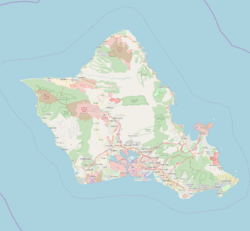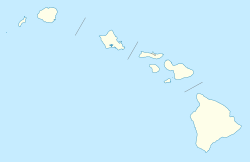Honolulu Stadium facts for kids
|
Termite Palace
|
|
 |
|
| Location | Honolulu, Hawaii, U.S. |
|---|---|
| Coordinates | 21°17′35″N 157°49′37″W / 21.293°N 157.827°W |
| Owner |
|
| Capacity | 25,000 |
| Surface | Natural grass |
| Construction | |
| Opened | November 11, 1926 |
| Closed | September 1975 |
| Demolished | December 1976 |
| Architect | Rothwell, Kangeter & Lester |
| Main contractors | Walker & Olund |
| Tenants | |
Honolulu Stadium was a famous sports place in Honolulu, Hawai'i. It was a multi-purpose stadium, meaning it could host many different sports. The stadium opened in 1926 and was the main sports venue in Hawai'i for a long time.
It was known as the "Termite Palace" because it was mostly made of wood and had a lot of termites. In its final years, about 25,000 fans could watch games there. The stadium was taken down in 1976. Today, a park called Old Stadium Park is in its place. A special plaque remembers the stadium at the corner of King and Isenberg Streets.
Contents
What Was Honolulu Stadium Like?
Honolulu Stadium was located in the Moʻiliʻili area of Honolulu. It was at the corner of King and Isenberg Streets. The stadium replaced an older field called Mo'ili'ili Field. That old field is now a park with two baseball fields.
How the Stadium Was Set Up
The stadium was designed for both baseball and football. For baseball, home plate was in the northwest corner. The third base line ran along King Street. The left field seating was next to Isenberg Street. The field was about 325 feet to left field and 305 feet to right field. Center field was about 430 feet away.
For football, the field ran through the baseball outfield. The football sidelines were in what would be the right field and along the third base line for baseball.
A Look Back at Honolulu Stadium's History
Honolulu Stadium was owned by a private company for most of its life. In 1975, the State of Hawaii bought the stadium. It cost $8.5 million.
Home to Many Teams
The stadium was home to the University of Hawaii's college football team. They played there from 1926 to 1974. It also hosted the Hawaii Islanders, a professional baseball team. They played in the stadium from 1961 to 1975. In its last years, a football team called The Hawaiians also played there.
Famous Events and People
Honolulu Stadium hosted many exciting events. It was the site of several important bowl games in college football. These included the Poi Bowl, Pineapple Bowl, and Hula Bowl. High school football games were also played there. The stadium even held world championship boxing matches. Sometimes, people would race stock cars there! In 1949, Hawai'i had its first night track meet at the stadium.
Many famous people visited Honolulu Stadium:
- Baseball legends Lou Gehrig and Babe Ruth played there in 1934.
- Joe DiMaggio hit a home run out of the park in 1944.
- Olympic champion Jesse Owens raced a horse in 1946!
- Musician Irving Berlin performed in 1945.
- Elvis Presley gave a concert in 1957.
- Preacher Billy Graham spoke to a huge crowd in 1958.
Memorable Games
One famous football game was in 1971. The University of Hawaii Rainbows played against the top-ranked Nebraska Cornhuskers. Nebraska was undefeated and won the game 45–3. They went on to win the national championship that year.
The very last event at the stadium was a baseball game. The Hawaii Islanders won their first championship in September 1975. They beat the Salt Lake Gulls. The stadium closed shortly after this victory. A new stadium, Aloha Stadium, opened the next week.



